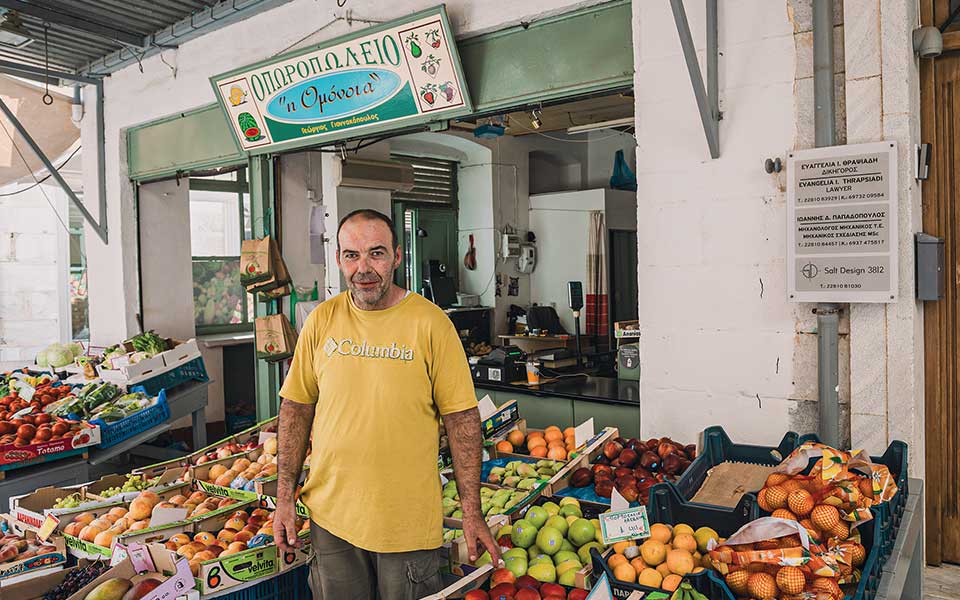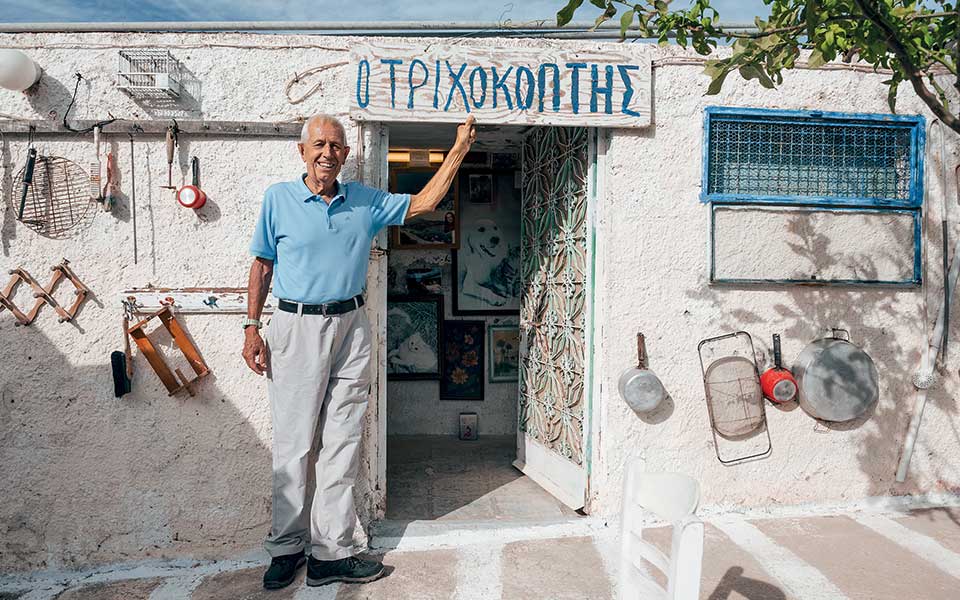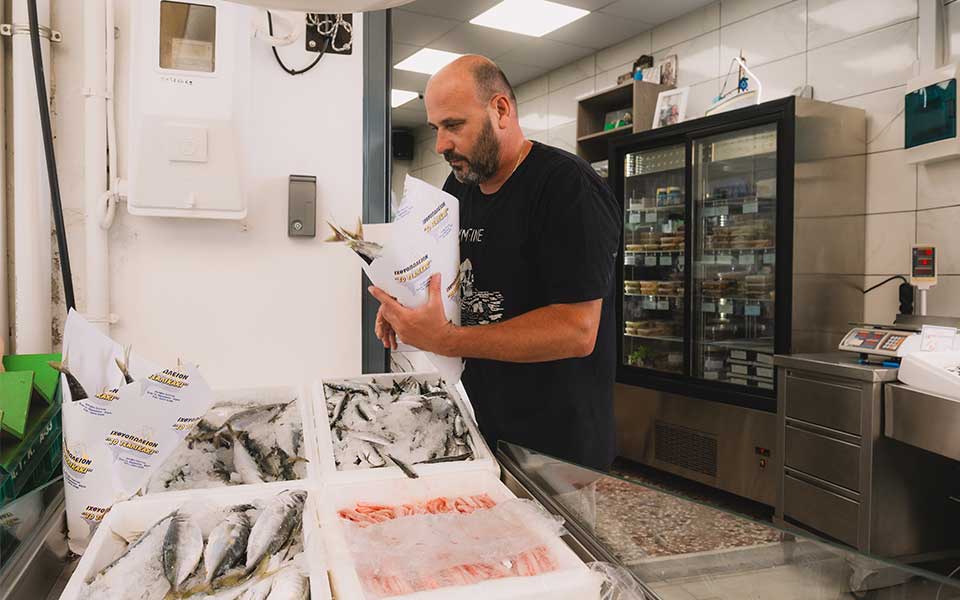Recipe: Original Sifnos Chickpea Stew (Revithada) in a...
The signature dish of the island...

The inscription marking the establishment of Greece’s first organized market, next to Miaouli Square.
© Υiorgos Vellis
Locals in Syros refer to Chiou Street as “Manavika” (the greengrocers). Until about twenty years ago, the street was lined with produce shops, whose fruits and vegetables added bursts of color to every corner, interspersed with butcher shops and general stores. Fishmongers clustered closer to the waterfront, while the nearby alleyways buzzed with commerce – cafes, tavernas, and an array of shops offering everything from tailoring and shoemaking to modern novelties and blacksmithing tools.
“The scent of wood from liqueur barrels, of green soaps and fresh fruits – it’s all so vivid in my mind. The smells are what bring the past to life; they stay with us,” says tour guide Peggy Stergiou, recalling the market’s lively atmosphere.

Revans Café, a favorite hangout for the youth of Syros.
© Υiorgos Vellis

Bouzouki player Antonis Fragkias performs folk and rebetiko music on Chiou Street.
© Υiorgos Vellis
The market’s roots stretch deep into the early 19th century, following the arrival of refugees from Chios. For two centuries, it thrived as the commercial heart of Ermoupolis. Founded during King Otto’s reign, it is believed to be Greece’s first market, which numbers the Pallas open-air cinema among its landmarks.
“In its early days, makeshift huts were built on stilts above the marshy land, which was later filled in to create the street we see today. When Ermoupolis grew into one of the largest commercial ports in the Mediterranean, the demand for goods boomed, and that’s when the market truly flourished,” explains Kostas Prekas, owner of the eponymous grocery store on Chiou Street, a staple since 1992. His shop features products from Syros and the rest of Greece, as well as a workshop where he makes local delicacies.
The rising demand spurred a boom in agricultural production, with rural farms proliferating outside the city. In 1976, Dutch agronomist Paul Kuipers introduced Greece’s first greenhouses to Syros, transforming the island into a key supplier of fresh produce, with shipments reaching as far as Athens.

A painting by Eugenios Petridis that once adorned the famous butcher shop of Markos Soubitzis.
© Υiorgos Vellis
Canvas awnings once stretched overhead, shading a vibrant marketplace that thrived from Miaouli Square to the sea. Beneath these canopies, a kaleidoscope of sights and sounds unfolded: shoppers haggling over fresh produce, flirtatious exchanges between young couples, and artisans offering their wares in a dizzying array of colors and smells.
Young apprentices, their arms burdened with baskets, scurried through the crowds, while donkeys delivered goods from the surrounding rural farms. Ice cream vendors wheeled their carts, calling out to children, while street vendors peddling kokoretsi (grilled offal) added a savory aroma to the air. In this bustling scene, live chickens clucked in cages and fresh fish glistened on display tables, all amidst the energy of everyday commerce. At night, drifters would sleep beneath the market stalls, adding to the market’s unfiltered, lived-in essence.

George Giannakopoulos, a third-generation greengrocer, continues his family’s tradition at the same location in the market.
© Υiorgos Vellis
Some remember that the market numbered as many as 17 greengrocers, while others recall the legendary grocery store “Kypseli” and the produce seller Dimitris Hatzigiannis, who famously dressed as Charlie Chaplin during Carnival, adding an extra layer of color to the market’s lively atmosphere. Then there was the cheerful Spinos, the fry cook who served up cones of crispy French fries, a simple yet unforgettable treat for market-goers. The stories go on: about Mr. Manolis, who crafted watches in a tiny kiosk, butcher Markos Soubitzis and the hawker, and Tzikas’s café, where pensioners spent their afternoons playing billiards and offering help to anyone in need of navigating the complex bureaucracy of the time.

Natsios Dakrotsis, a former apprentice and later a butcher in the market.
© Υiorgos Vellis

Kostas Prekas contributes to preserving the market’s heritage with his grocery store, offering products from Syros and the rest of Greece.
© Υiorgos Vellis
Mr. Natsios Dakrotsis began his apprenticeship at Spinos’s legendary fry shop at the age of ten. “The market was packed, shoulder to shoulder. It was open every day, and during the holidays, we worked late into the night. Apprentices carried groceries to Syros households in large baskets – one on their back, one on their chest. But I mostly worked in the fry shop, running the occasional errand about potatoes. Later, I went to Soubitzis’s butcher shop. As I grew older and learned the trade, I became a butcher and a slaughterman.”
Barber Antonis Rigoutsos, known as “Trichokoptis” (The Haircutter), fondly remembers the endless banter he shared with his neighbor, François, the greengrocer.

Barber Antonis Rigoutsos, known as “Trichokoptis” (The Haircutter), ran his barbershop until 2007.
© Υiorgos Vellis
The two men even reprised their old roles for the reenactment event “The Old Market of Ermoupolis,” organized a few months ago by the cultural organization Hermoupolis Heritage in collaboration with the Friends of Syros Gastronomy. “As with all our events, the goal was for the people of Syros themselves to learn the history of their place, and we were delighted to see such a huge response. For the older generation, it revived cherished memories, while the younger ones got a glimpse of what the market was like once. Those who attended not only enjoyed themselves but also gained valuable insights. Our aim is for locals to understand their history and culture and to share it in a personal, meaningful way with visitors,” explains the organization’s founder, Dimitris Stavrakopoulos.
He acknowledges that a single event cannot bring about sweeping change, but he hopes this revival might inspire other organizations or public bodies to take similar initiatives.

The open-air cinema “Pallas,” located inside the first organized marketplace that was established during King Otto’s reign.
© Υiorgos Vellis
For younger generations, it was a rare opportunity to connect with the market’s rich past, thanks in part to photographs from the Ermoupolis Historical Archive. The archive has also recorded interviews with veteran merchants, documenting the many transformations of each shop over the years.
Today, however, the market no longer resembles the vibrant hub it once was. Its decline is the result of several factors: the rise of supermarkets, reduced agricultural production due to water shortages and increased tourism, and the lifting of parking restrictions along the waterfront. The arches that once defined the space have been covered in plaster, and drywall obscures the stone walls and high ceilings where goods once hung. The once close-knit marketplace has lost its identity; walking along it now, one encounters either closed shops or businesses unrelated to its gastronomic heritage.

The fish market “Tsalikaki” has operated in the market for 40 years. Previous generations of owners sold fish from carts or carried them in baskets on their heads.
© Υiorgos Vellis
Only a few businesses remain as the last vestiges of the old market. The greengrocers Giannakopoulos and Roussounelos, along with the fish market “Tsalikaki,” are still going strong after generations. Babis Dalezios, who opened his butcher shop “Salimbaki” in 1997, has also contributed to preserving the market’s former character. Hanging Syros louza (cured pork) and fennel sausages on hooks, he brings back a taste of the past, offering a small but meaningful nod to the old marketplace. Restoring Chiou Street to its former glory, however, would require initiatives on the part of the merchants, as well as incentives and support from the authorities.

Tour guide Peggy Stergiou recalls that the market was vibrant until 2000.
© Υiorgos Vellis
George Giannakopoulos shares this view, arguing that the people of Syros still value the personal care and quality offered by a greengrocer over the impersonal service of supermarkets. During the summer, he stays open late into the evening, as do other merchants, ensuring that yachts docking in Syros can find open shops for their supplies. “All the shops together create a kind of department store – who needs supermarkets?” he says with a smile.
The signature dish of the island...
From kafeneia serving souma and meze...
Discover festivals, beaches, food, and hidden...
From traditional dances and global rhythms...